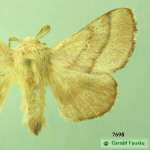Family Lasiocampidae: Lappet moths/ Tent caterpillars
| Diagnosis: Proboscis vestigial or absent; fw
venation quadrifid,
CuA2 arising closer to wing base than
end of discal cell; hw with either a moderate to large basal areole or two humeral veins; hind tibiae
usually with apical spurs only.
Diversity: Worldwide five subfamilies, 150 genera and 1500 species; North America has two subfamilies, 11 genera, and 34 species; seven species in four genera are known from the Dakotas. Checklist numbers: 7669- 7703. Biology: Females lay large numbers of eggs Larvae are arboreal foliage feeders. Some species live in communal nests (tents). Adults have atrophied mouthparts, females usually sedentary until after fertilization.
|
|
| Further reading:
Fitzgerald, Terrence D. 1995. The tent caterpillars. Cornell Univer. Press. Ithaca, N.Y. 303 pp. Franclemont, John G. 1973. Fascicle 20.1 Mimallonoidea Mimallonidae and Bombycoidea Apatelodidae, Bombycidae, Lasiocampidae in Dominick et al. The moths of America north of Mexico. E. W. Classey Ltd. London. 86 pp. Lemaire, Claude and Joël Minet. Chapter 18. The Bombycoidea and their relatives, pp. 321- 353 in Kristensen, Neils P. ed. 1999. Lepidoptera, moths and butterflies. Part 35, Vol. 1 in Handbook of Zoology. Maximilian Fischer ed. Walter de Gryter, New York. 491 pp. Scoble, Malcom J. 1992. The Higher Ditrysia, Chapter 12, pp. 290- 341 in The Lepidoptera: form, function, and diversity. Oxford Univ. press. 1982. 404 pp. Stehr, Fredrick W. and Edwin F. Cook. 1968. A revision of the genus Malacosoma Hübner in North America (Lepidoptera: Lasiocampidae): systematics, biology, immatures, and Parasites. Bull. U. S. Natl. Mus. 276: 1- 319.
|
|
